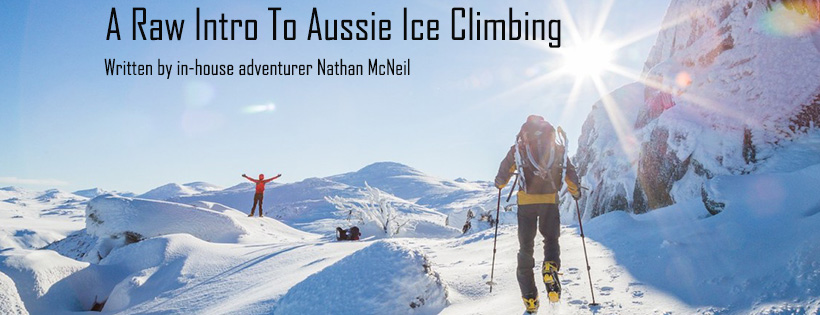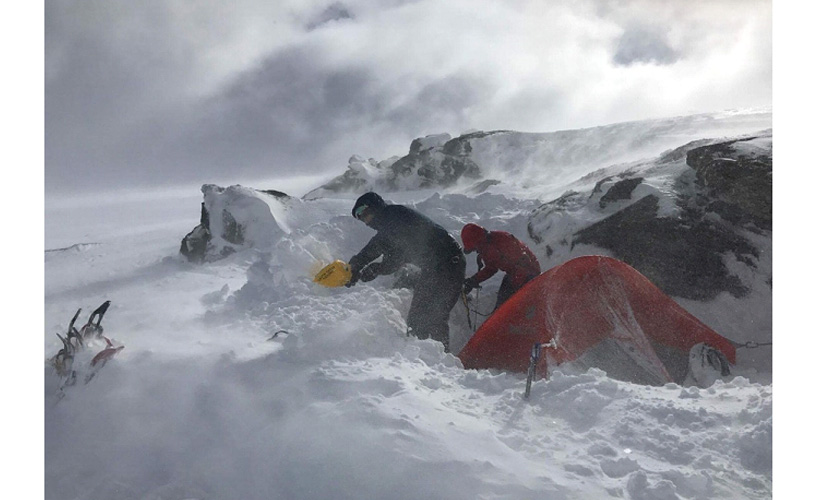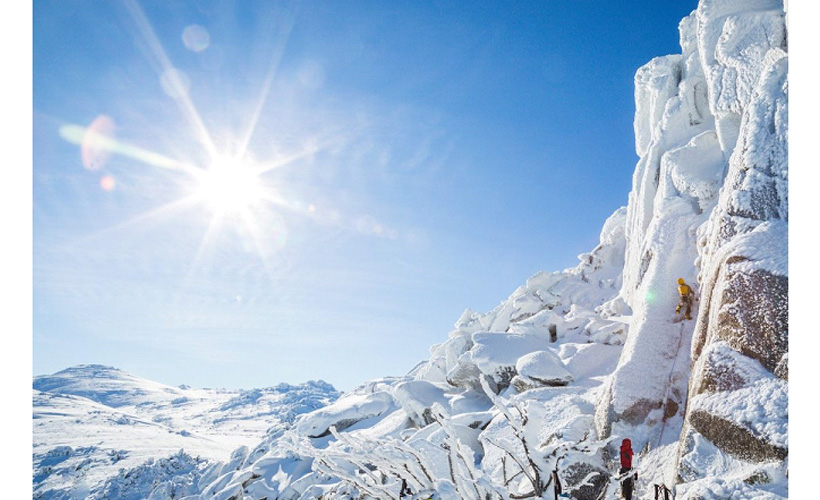Total Items: 0
Sub Total: $0.00
26.07.2018

Blue Lake - South Rams Head NSW
Go ice climbing” they said, “It’ll be fun” they said. That’s what kept running through Nathan’s mind every time he had to force himself to leave his tent to shovel snow in the blistering cold and gale force winds. Leaving Blue Lake behind, he eventually got to dig his axe deep into ice at South Rams Head, but was it worth it?
-Learning to move in an alpine environment
-Learning how to survive in extreme alpine conditions
-Learning the tools & equipment necessary for ice climbing and alpine adventures
-Suffering for days (only a highlight when you look back on it)
Snowshoeing From Guthega To Blue Lake
Last year was a year of firsts for me and ice climbing was at the top of my list. I invited myself on a trip that a few mates (who are experienced alpinists) were putting together to hit the ice at Blue Lake in Kosciusko National Park, NSW.
The goal was for them to teach me the technical skills and techniques required to move safely and efficiently in an alpine region, camp in the snow and climb ice safely.
Despite the long drive and lack of sleep on the way down from the Gold Coast, stoke was high as we pulled into Jindabyne at around 4.00am on a Sunday morning. We took over the carpark in the centre of town, did a final gear sort, drank coffee and headed for Guthega Station. It was my first time snowshoeing so, for me, the first hour or so was spent mostly getting the snow out of my daks but I was a master by the time we got to the Illawong Bridge.
We finally made camp around 5.00pm that afternoon near Mount Twynam as we figured it wasn’t far on foot to Blue Lake to climb each day and we had found a nice little overhanging rock that was shielding us from prevailing winds (which at the time weren’t that bad). We established camp and everything was hunky dory, we even built a small snow wall next to my tent which was at the front of the head winds, as the other 2 tents used me as shelter.
Leading into this trip (as with any trip into the mountains) we were all over the weather forecast in the lead up to our departure and on the drive south. The forecast showed that some bad weather was on the move towards our destination, but it wasn’t a big system with only a slight increase in wind and decreased visibility for the first day. Sounds fine right?
When Things Changed
About 9.00pm on the first night everything changed. Prevailing wind direction had changed and winds had increased to over 90km/h. The rock we were using for shelter was now only helping the wind funnel into our camp and bring with it massive amounts of spindrift (snow moved by wind). We spent the next 24 hours taking shifts, digging our tents out from under the snow as the weight was having a severe impact on the structural components of our underequipped tents. I remember lying awake all night thinking “Please be gone by tomorrow, please be gone by tomorrow” and hoping that it was just the system we had seen on the forecast with a little more intensity – and that it’d be gone in a day as predicted.
We kept a constant eye on the forecast to see when a clearing was in sight, but things just seemed to get worse. The winds increased every few hours but every now and then we’d get a glimpse of sunlight and the winds would calm slightly as if to give us just that little bit of hope, before things deteriorated again.

All we could do was huddle in our tents, eat, drink coffee, shovel and pray that the tents would hold up. There was no clearing on the horizon for another 2 days and even then our weather window was only forecast to last for 1 day. After a group discussion late on the second night, we decided as a team that we would break camp at dawn and head back to town to regroup and thaw out. It simply wasn’t worth enduring 5-6 days of intense mountain weather for 1 day of climbing ice that could have been built up with spindrift anyway.
At dawn the next day, the winds were at their peak and we struggled to break camp. Most equipment was frozen or buried and everybody was lacking energy due to minimal sleep. We mustered what energy we had left and after a 4 hour pack down we made haste back to Guthega Station. The Illawong bridge was a sight for sore eyes, knowing that the end was near. Finally, we were back at the car and headed into town to find the cheapest room for us all to squeeze into.
Plan B
After thawing out we decided that we weren’t going to leave Jindabyne without finding some ice to climb. So, after a day of rest (we actually went snowboarding at Thredbo instead), we had an alpine start and headed for South Rams Head. This spot was offering a few climbable routes and a shorter (but steeper) approach that gave us an easy option to bail should the weather turn on us again as forecasted. Being new to this form of suffering I questioned whether or not my body would be able to handle another hard approach, but my decision to go was solidified when my mate Scotty offered to carry most of my gear… cheers Scotty!
We drove the 45 minutes from Jindabyne along the Alpine Way, past Thredbo and parked just a few minutes past the Dead Horse Gap turn out. From here we made a beeline towards the highest rocky peak you can see and wound our way through the trees for about 1.5 hours, steadily getting steeper as we went. It was a beautiful walk up with low cloud filling the valleys around us and the early morning sun casting beautiful long shadows across the snow-covered backcountry.
The sight when we arrived at South Rams Head on a bluebird morning was one that I won’t forget! We found tall pillars covered in climbable rime ice which was perfect for learning on. The first moment when your axe hits the ice and you move upwards, step by step, using the toe spike of your crampons as footers, was an incredible feeling and almost made our suffering for the previous few days worthwhile (almost).
My first climb on ice finished through an icy squeeze-hole, definitely an experience you don’t get with the normal sport climbing that I’m used to. Although the climbing was minimal and the suffering was high, it was still a trip that I’m glad I went on!

The Takeaways
I learnt a lot of valuable lessons on this trip and even though the intention was to learn the technical skills required to climb ice safely, the undeniable lesson was that mother nature can change your plans in an instant and that you need to be prepared for that.
We were as prepared as we could have been and the people that I went on this trip with were experienced alpinists, two of them having summited 4,000m+ peaks and spent many days climbing ice around the world, but still, Mother Nature had the final say.
The whole reason we seek out wild places is to find adventure, but the skills I learnt on this trip, how to survive and what to do when the weather turns bad, were probably more important. You can learn in a controlled environment, but nothing compares to the real thing.
Essential Gear
4 season tent (wish I had one)
Showshoes or cross-country skis
Walking poles with snow baskets
Gore-Tex clothing
Down/insulated clothing and merino base layers
Mountaineering boots (glad I had a double boot)
2 pairs of gloves + liners (1 for working in and 1 for tent)
PLB
First aid kit and map + compass
Quality backpack
Quality socks (spare pair for bed)
Freeze dried food and coffee
Ice climbing gear (if that’s your plan)
Camera gear (the Kosciusko backcountry is beautiful if you get good conditions)
Head torch and spare batteries
Solar charging equipment (you can get a spot of service so good idea to have stuff to charge your phone so you can check weather forecasts or post a selfie)
Snow shovel and snow saw (for building base camp)
How To Get There
Blue Lake is located approximately 5-6hrs via snowshoe from Guthega Ski Centre along the Illawong Track and across the Snowy River via the Illawong Bridge. Guthega carpark is located an hour from Jindabyne via Guthega Road. Follow the trail marked “Illawong Walk” until you reach the Illawong Bridge (approx. 1-2hrs by foot in winter). From here head west towards Blue Lake for approx. 4 hours, follow your nose along the path of least resistance, gradually getting higher and further from the Snowy River. You can choose to camp in the trees at the base of Mt Twynam which offers much better shelter but means longer on foot each day to Blue Lake or establish camp closer to Blue Lake and be more exposed.
South Rams Head is located approx. 1.5 hours via snowshoe from Dead Horse Gap turnout on the Alpine way. The carpark is approx. 45 minutes drive from Jindabyne. From the carpark, head north towards the tallest rocky peak you can see, winding your way upwards through the trees gradually getting steeper. Once you get up around the peak you will see lots of climbable pillars. We chose to traverse another 10-15 minutes further along until we found a tall pillar we liked. A lot of good backcountry skiing is also on offer in this region
Note: Camping restrictions apply around catchments, find more info here.
Activities
Back country hiking/skiing/snowboarding
Ice climbing (if conditions allow)
Photography
Suffering
Skill Level
Advanced.
Some skill is required to attempt a trip of this nature. You need to know how to manoeuvre in an alpine environment, knowledge of the area or good navigation skills, ice climbing experience and competency with rope work, belay and rappel experience in alpine conditions. It can be incredibly dangerous if you’re unprepared for bad weather or attempt to ice climb without the necessary skills.
I would not recommend attempting a trip like this unless you have the necessary experience or are with friends who do and are willing to teach you.
Distance Covered / Elevation Gain / Time Taken
Blue Lake is 6-7km each way from Guthega Station covering varying terrain. Elevation gain will vary depending on the chosen path but it’s approx. 500m. In winter allow 5-7 hours depending on knowledge of the area, navigational skills and weather conditions.
South Rams Head is 1-2km each way from Dead Horse Gap covering sustained terrain. Elevation gain is around 500m as Blue Lake and South Rams Head share a similar elevation. Allow 1-3 hours from car to peak depending on weather conditions underfoot. Navigation is much easier in this region.